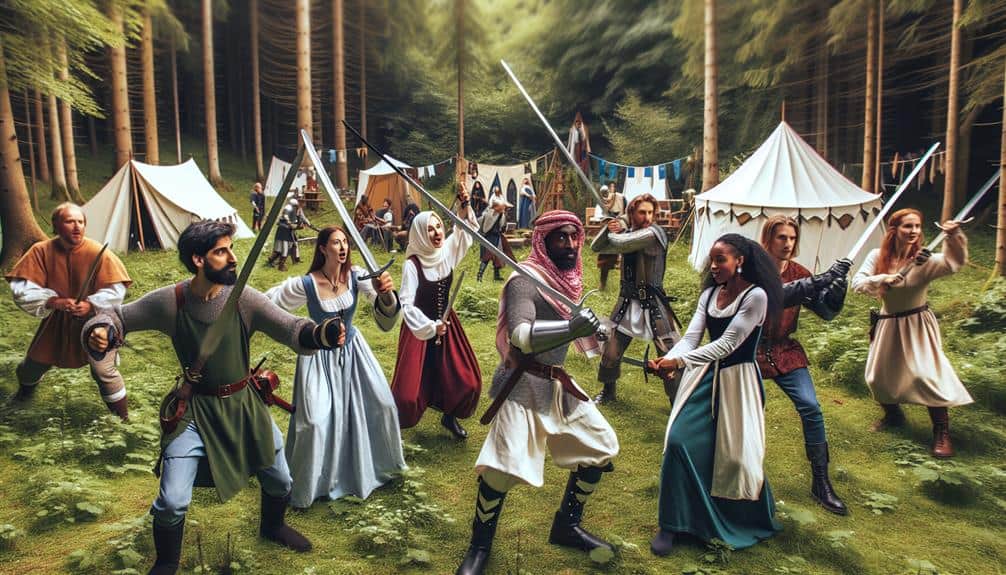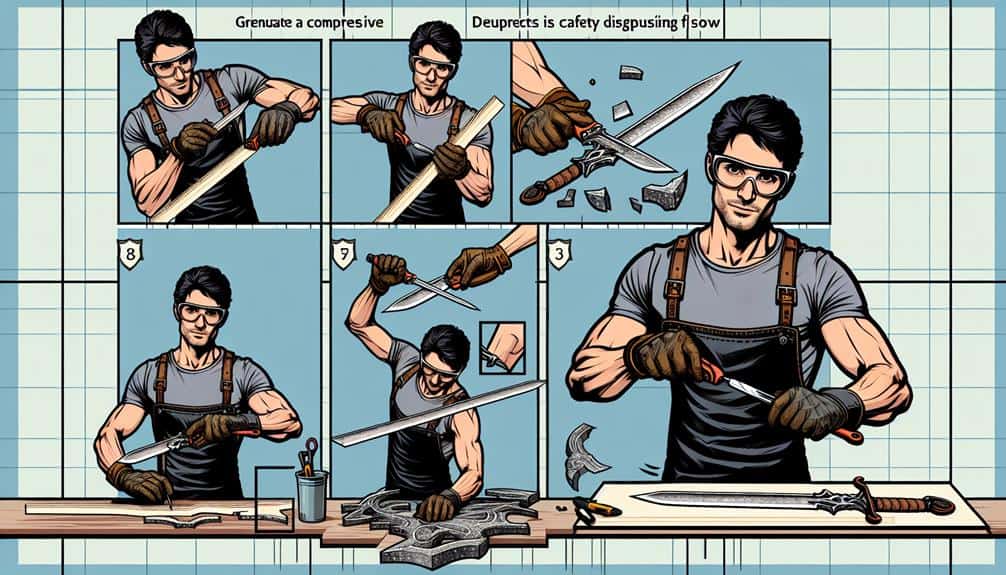Have you ever considered the profound impact a well-crafted story can have on your LARP experience?
Picture a domain where characters come alive, dialogue crackles with intrigue, and plot twists keep you on the edge of your seat.
By implementing seven key techniques, you can elevate your storytelling prowess and captivate your fellow players in ways you never thought possible.
From setting the stage to embracing collaborative storytelling, each method holds the power to transform your narratives into unforgettable adventures.
Key Takeaways
- Create immersive worlds with detailed descriptions and vibrant environments.
- Develop complex characters with intriguing backstories and dynamic relationships.
- Introduce plot twists, betrayals, and conflicts to engage players.
- Enhance storytelling with detailed props, costumes, and collaborative narrative building techniques.
Setting the Stage
To set the stage effectively for your LARP storytelling experience, immerse players in a vibrant and detailed world from the moment they step into the game. Creating an immersive atmosphere is essential to engage your players fully. Start by paying attention to environmental details. Describe the sights, sounds, and smells that surround them. Set the scene with vivid imagery, painting a picture of a world that feels tangible and alive. Incorporate elements like weather effects, ambient noises, and interactive props to enhance the player's experience.
Consider the placement of objects within the game space to provide context and create a sense of realism. From the layout of furniture to the placement of mysterious artifacts, every detail should contribute to the overall atmosphere. Encourage players to interact with their surroundings, touching, inspecting, and exploring the environment to uncover hidden secrets and clues. By immersing players in a richly detailed world, you can transport them to a place where their imagination can truly thrive.
Crafting Compelling Characters
Craft your characters with depth and complexity to captivate players and enrich the LARP storytelling experience. When crafting compelling characters for your LARP, consider these key techniques:
- Create Intriguing Backstories: Develop detailed and rich backstories for your characters, including their motivations, fears, and desires. This will add depth and complexity to their personalities.
- Establish Dynamic Character Relationships: Build intricate relationships between characters to create engaging dynamics. Whether it's a rivalry, friendship, or secret alliance, these relationships can drive the story forward.
- Reveal Layers Over Time: Slowly disclose different layers of your character throughout the LARP. This gradual disclosure keeps players intrigued and invested in discovering more about them.
- Incorporate Flaws and Conflicts: Give your characters flaws and internal conflicts that make them more relatable and human. These imperfections add realism and depth to the character.
- Allow Room for Character Growth: Provide opportunities for your characters to evolve and grow throughout the LARP. This growth can be influenced by their interactions with other characters and the unfolding events in the story.
Engaging Dialogue Dynamics
Immerse players in intense and dynamic interactions by mastering the art of engaging dialogue dynamics in your LARP storytelling. Dynamic interactions are the lifeblood of engaging storytelling, making character relationships come alive in your game world. To achieve this, focus on creating dialogue that isn't only informative but also emotionally charged. Encourage players to explore deep into their characters' motivations, desires, and fears through their interactions.
One technique to enhance dialogue dynamics is to introduce conflicts that push characters out of their comfort zones. This can lead to powerful exchanges that reveal new facets of the characters and deepen their relationships. Another strategy is to incorporate secrets and revelations into conversations, adding layers of intrigue and complexity to interactions.
Plotting Intriguing Twists
Plotting intriguing twists in your LARP storytelling can elevate the excitement and unpredictability of your game world, keeping players on the edge of their seats. To achieve this, consider the following techniques:
- Unexpected betrayals: Introduce surprising betrayals where allies turn into enemies, leaving players shocked and questioning loyalties.
- Dramatic disclosures: Disclose hidden secrets or truths in a dramatic fashion, creating impactful moments that alter the course of the narrative.
- Intricate webs: Craft complex webs of relationships and schemes that players must navigate, leading to unexpected connections and conflicts.
- Hidden motives: Give characters hidden motives that only come to light through subtle hints or major revelations, adding depth to interactions.
- Twists within twists: Layer multiple twists within a storyline, keeping players engaged and constantly reevaluating their strategies and alliances.
Utilizing Props and Costumes
Imagine this: donning intricate costumes and wielding authentic props can transport you to the heart of your character's world, enhancing your immersion in the LARP experience.
By setting the scene with carefully selected items, you can elevate the storytelling and create a more dynamic and engaging environment for all participants.
Let the costumes and props become extensions of your character, breathing life into the narrative and enriching the overall adventure.
Enhancing Character Immersion
Enhance your character immersion in LARP by incorporating authentic props and costumes that bring your role to life. Dive deeper into your character development and emotional roleplay with these techniques:
- Detailed Costumes: Wear clothing that reflects your character's personality and background.
- Personalized Props: Use props that are meaningful to your character's story and motivations.
- Functional Props: Incorporate props that serve a purpose in interactions and gameplay.
- Interactive Costumes: Choose costumes that allow you to move comfortably and interact with others seamlessly.
- Weather-Appropriate Gear: Make sure your costumes and props are suitable for the LARP environment to enhance realism and your overall experience.
Setting the Scene
To fully transport yourself and others into the world of your LARP setting, strategically integrate props and costumes that embody the essence of the environment and characters. Creating atmosphere is key; for example, if your LARP is set in a medieval world, consider using torches, banners, and rustic furniture to set the scene. These props can instantly transport players to a different time and place.
Costumes play a vital role in building tension and enhancing the overall experience. Encourage participants to dress the part with period-appropriate attire, armor, or mystical robes. The sound of clashing swords, the flickering of candlelight, and the rustling of robes can make the setting come alive, immersing everyone in the adventure.
Mastering Pacing and Climaxes
Crafting the perfect pacing in your LARP story will elevate the experience for all participants. To master pacing and climaxes, consider the following:
- Tension Buildup: Slowly increase the intensity of conflicts and challenges to keep players engaged.
- Dramatic Conclusions: Guarantee the resolution of major story arcs is satisfying and impactful.
- Emotional Rollercoaster: Take players through highs and lows, creating a dynamic and engaging experience.
- Impactful Endings: Conclude storylines with a bang, leaving players with a sense of accomplishment or intrigue.
- Player Agency: Allow participants to influence the pacing through their actions, making the story feel more immersive and responsive.
Embracing Collaborative Storytelling
Imagine a world where stories are born from the minds of many, not just one. Picture a kingdom where each character holds a brush to paint the plot's canvas.
Together, you and your fellow players shape the tale, weaving a tapestry of adventure through shared narrative creation, player character input, and group plot development.
In the domain of collaborative storytelling within LARP, weaving together individual narratives into a cohesive tapestry enhances the immersive experience for all participants. By embracing shared narrative creation, you uncover the heart of player agency and group dynamics, revealing a world of possibilities.
Here are five techniques to enhance your collaborative storytelling:
- Establish Common Goals: Aligning character objectives can lead to cohesive storytelling.
- Encourage Active Listening: Pay attention to others' narratives to build upon them effectively.
- Embrace Improvisation: Be flexible in how you contribute to the evolving story.
- Celebrate Diverse Perspectives: Welcome different viewpoints to enrich the narrative tapestry.
- Foster Trust: Create a safe space for collaboration to flourish and deepen the storytelling experience.
Player Character Input
To enhance the depth and richness of collaborative storytelling in LARP, inviting and integrating player character input is a pivotal element that breathes life into the shared narrative experience. When players actively contribute to character development, they infuse the story with unique perspectives, motivations, and complexities.
Embracing player agency allows for organic growth and unpredictability in plot progression, leading to more immersive and engaging narratives. By valuing player character input, LARP experiences become dynamic and responsive, creating a fertile ground for creativity and exploration.
Players feel empowered and invested in the unfolding story, fostering a sense of ownership and connection to the world they collectively inhabit. In this collaborative environment, character development thrives, and storytelling reaches new heights of depth and authenticity.
Group Plot Development
Embrace the collaborative spirit of group plot development in LARP by immersing yourself in the diverse narratives of each participant, culminating in a tapestry of shared storytelling that captivates and enthralls all involved.
Plunge into the heart of collaborative worldbuilding, where every player contributes a thread to the intricate narrative fabric. Explore group conflict resolution with finesse, transforming challenges into opportunities for character growth.
Delve deep into character relationships, intertwining arcs to create a web of intrigue and emotion. Infuse your plots with dramatic tension, keeping players on the edge of their seats as the story unfolds.
Embrace the power of collective imagination, where every idea is a building block in the grand saga you craft together.
Frequently Asked Questions
How Can I Handle Conflicts Between Players During LARP Events?
When conflicts arise between players during LARP events, focus on conflict resolution through roleplay etiquette and understanding player dynamics. Engage in open communication, encourage respectful player interactions, and use storytelling to navigate challenges.
Are There Any Specific Techniques for Incorporating Music and Sound Effects Into LARP Storytelling?
To enhance your LARP storytelling with music and sound, focus on soundtrack selection for immersive ambiance. Implement sound effects for dramatic impact. Use music cues to guide emotions and create a truly engaging experience for all participants.
What Is the Best Way to Handle Unexpected Player Actions That Deviate From the Planned Storyline?
Handling surprising player actions requires narrative flexibility. Embrace player improvisation as an opportunity to enhance storytelling. Adapt swiftly, weaving their choices seamlessly into the overarching plot. Stay agile, allowing for dynamic and engaging gameplay.
How Can I Effectively Manage Player Expectations and Ensure Everyone Has a Satisfying Experience?
To manage player expectations effectively and guarantee satisfaction in your LARP experience, focus on clear communication, setting realistic goals, and fostering open dialogue. Engage players in the storytelling process to create a collaborative and fulfilling journey.
Are There Any Tips for Creating Immersive and Detailed Environments for LARP Events?
To create dynamic landscapes for LARP events, immerse players in engaging sensory experiences. Use vivid descriptions, realistic props, and interactive elements. Transport them to fantastical domains where every sight, sound, and touch enhances their adventure.



